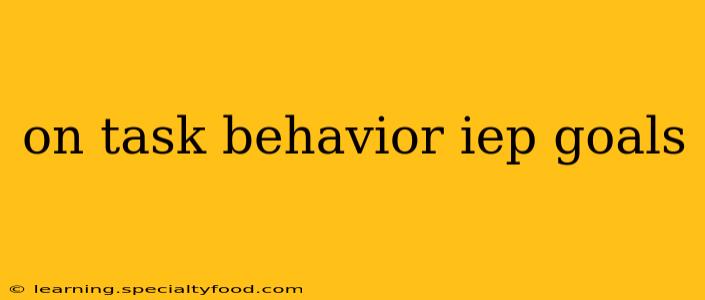Creating effective IEP goals for on-task behavior requires a nuanced understanding of the student's specific needs and challenges. This guide will delve into crafting measurable, achievable, and relevant goals, addressing common questions and providing practical examples. We'll explore strategies to improve on-task behavior and discuss the crucial role of collaboration between educators, parents, and the student themselves.
What are On-Task Behavior IEP Goals?
On-task behavior IEP goals focus on increasing a student's engagement in academic activities and reducing disruptive or off-task behaviors. These goals are tailored to the individual student's needs, considering their age, developmental level, learning style, and the specific behaviors that interfere with their learning. They're not simply about sitting still; they're about actively participating in learning activities.
How to Write Effective On-Task Behavior IEP Goals
Effective IEP goals follow the SMART criteria: Specific, Measurable, Achievable, Relevant, and Time-Bound.
-
Specific: Clearly define the target behavior. Instead of "improve on-task behavior," specify the behavior, such as "remain seated during instruction," "actively participate in class discussions," or "complete assigned work independently."
-
Measurable: Establish how the behavior will be measured. This might involve using data collection methods like frequency counts, duration recordings, or percentage of time on-task. For example, "Will independently complete 80% of assigned seatwork within a 45-minute class period" or "Will remain seated for at least 30 minutes of a 45-minute lesson for 4 out of 5 days."
-
Achievable: Set realistic and attainable goals. Start with small, manageable steps and gradually increase the expectations as the student progresses.
-
Relevant: The goals should directly address the student's academic needs and learning objectives. They should be aligned with the overall IEP and the student's educational program.
-
Time-Bound: Specify a timeframe for achieving the goal. This might be a semester, a marking period, or even a shorter period, depending on the complexity of the goal.
Examples of On-Task Behavior IEP Goals
Here are some examples of well-written on-task behavior IEP goals, illustrating the SMART criteria:
-
Goal: Increase independent seatwork completion.
- Measurable: Student will independently complete at least 75% of assigned seatwork during a 45-minute period, as measured by teacher observation and data collection, for four out of five school days within the next six weeks.
-
Goal: Reduce off-task behaviors during instruction.
- Measurable: Student will exhibit off-task behaviors (defined as leaving seat without permission, talking out of turn, or engaging in non-instructional activities) no more than three times during a 45-minute lesson for four out of five school days, as measured by teacher observation and data collection, within the next eight weeks.
-
Goal: Improve participation in class discussions.
- Measurable: Student will contribute at least two relevant comments or questions to class discussions during each 45-minute lesson for four out of five school days, as measured by teacher observation and anecdotal notes, within the next 10 weeks.
What Interventions Support On-Task Behavior?
Many strategies can support on-task behavior. These should be individualized based on the student's needs and preferences:
- Positive Reinforcement: Reward positive behaviors with praise, incentives, or privileges.
- Visual Supports: Use visual schedules, timers, or checklists to help students stay organized and on track.
- Environmental Modifications: Adjust the classroom environment to minimize distractions.
- Behavioral Interventions: Implement strategies like Functional Behavior Assessments (FBAs) to identify the underlying causes of off-task behavior and develop appropriate interventions.
- Self-Monitoring Strategies: Teach students to monitor their own behavior and provide self-reinforcement.
- Movement Breaks: Incorporate short movement breaks into the school day to help students refocus their attention.
How are On-Task Behavior Goals Measured and Monitored?
Regular monitoring is crucial. Teachers use various methods to track progress towards on-task behavior goals:
- Direct Observation: The teacher observes the student's behavior during class and records data.
- Data Collection Sheets: Teachers use specific forms to record instances of on-task and off-task behaviors.
- Anecdotal Records: The teacher keeps brief notes about the student's behavior in specific situations.
- Self-Monitoring: The student tracks their own behavior using a chart or checklist.
What if the Student Isn't Meeting the Goals?
If the student isn't meeting the goals, the IEP team should meet to review the goals, interventions, and data. They may need to adjust the goals, implement new interventions, or consider additional support services. The key is flexibility and collaboration to ensure the student receives the best possible support.
This comprehensive guide provides a solid foundation for developing effective on-task behavior IEP goals. Remember, collaboration and a data-driven approach are essential for achieving success.
